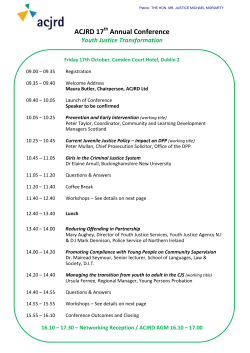
Challenges for Probation in South Asia
Development of probation and parole in Bangladesh and India Nikhil Roy Penal Reform International www.penalreform.org @PenalReformInt Why is probation important in South Asia? • Overcrowding – Bangladesh occupancy level : 214.8% – India occupancy level: 112.2% • Pre-trial detention – Bangladesh: 68.3% – India 66.2% www.penalreform.org Legislative basis of probation • What laws does probation come under? • What crimes is probation used for? • What duties of probation officers are set out in legislation? www.penalreform.org Weaknesses in implementation • • • • • • • Awareness Attitudes Inter-agency cooperation Structure Capacity Quality personnel Reformative elements to reformation www.penalreform.org Good practice • Andhra Pradesh • Tamil Nadu www.penalreform.org Wider questions • Is probation the best way to reduce overcrowding and large percentage of PTD prisoners in South Asia? • Should it be invested into in India / Bangladesh / both or is better to begin other alternatives to imprisonment projects – CSOs, mediation, and using traditional justice structures? www.penalreform.org More information can be found at: www.penalreform.org And at our stall in the marketplace! Follow us on Twitter @PenalReformInt www.penalreform.org Probation and Parole in Pakistan Zakir Shuaib Freelance consultant, PRI Associate zakirshuaib@yahoo.com www.penalreform.org @PenalReformInt Why probation and parole for Pakistan? • More pre / under trial detentions • Non existent or traditional rehab services • Overcrowded prisons – poor prison management – dismal health hygiene conditions – torture and other exploitation – high risk behaviours – Increased risk of criminalisation/ extremism www.penalreform.org Legislative basis • Pakistan inherited the Judicial System of the Govt of British India – Reclamation & Probation Departments (RPDs) established in 1927 – Good Conduct Prisoners Probational Release Act 1926 – Sections 380/562/564 Indian Code of Criminal Procedure – (All India Probation Bill drafted) • Only Province of Punjab has its own RPD • Rest of the provinces established RPDs in 1957 www.penalreform.org Current legislative basis • The probation of offenders ordinance 1960/ Rules 1961 • The Good Conduct Prisoner Probational Release Act of 1926 • Juvenile Justice System Ordinance 2000/ Rules www.penalreform.org Legal provisions for non-custodial sanctions – Bail: at the Pre/during trial stage – Probation/ fines: at the sentencing stage – Parole: Post sentencing (during imprisonment) www.penalreform.org Structure Director Probation and Reclamation Deputy Director Assistant Directors District Probation Officers www.penalreform.org District Parole Officers Assistant Directors Structure: Province-wise strength staff Province Director Deputy Dir. Asst Probation Dir Officer Parole Officer Male Female Male Female Total Punjab 1 1 10 53 4 16 4 89 KPK 1 1 0 21 7 2 0 32 Sindh 1 0 2 15 1 14 0 33 Balochistan 1 2 2 7 2 5 1 20 www.penalreform.org Probation process Offender appears in Court Judge directs PO to prepare SIR Back to community supervised by PO for 1 to 3 year Released on probation original sentence suspended or postponed No satisfactory change PO violated successful completion Original sentence no more applicable SIR prepared and presented in Court probation orders issued Probation denied Prison Scope of Probation system and limitations • Extended to offences mostly of minor nature and first time offenders • Somewhat discriminatory – male offenders are less likely to be released on probation than female www.penalreform.org Parole process Prisoner/family / Govr Prison/ PO Submit appl. Parole Committee Appl. Reviewed & advised Home Sec Home sec on the recommendation of PC gives approval Successful completion Employed on daily wages supervised by the PO Prisoner released on parole Or appl. rejected License violated Prison No satisfactory change PO violated www.penalreform.org Scope of Parole system and limitations • Restrictions on parolees – To be employed minimum 45 miles away from the family – Can’t live with their families before six month of parole period. – No direct access to their monies – No personal Bank Account www.penalreform.org Province-wise data of Probationers and Parolees Province Probationers Parolees Total Male Female Juvenile Punjab 21510 243 247 150 22150 KPK 1697 33 59 14 1803 Sindh 950 0 ? 50 22 1022 Balochistan 20 0 ? 5 76 101 www.penalreform.org Positive developments • Provincial RP Directorates established • New posts sanctioned/ recruited • Releases on probation comparatively increased (particularly of juveniles offenders) • Probation officer now member of the DCJCC • Parole Committees established at provincial level www.penalreform.org Areas for improvement • Insufficient funds allocation • Inadequate human, material resources and poor skills development • Lack of or less-effective multiagency working for rehabilitation of released P/P • Insufficient means of communication (transportation, phone/fax machines) • Data collection and management www.penalreform.org Areas for improvement • Poor implementation of existing laws • Lack of interest/confidence of the judiciary and legal counsel on the existing probation & parole system • Inadequate training facilities for staff • Poor coordination among key partners • No provision of community service in the probation law www.penalreform.org Wider challenges and issues for the penal system • Overcrowded prisons • Lack of political will / not a priority area for Govt. • Attitudes of Judiciary, Police, Lawyers towards non custodial sanctions • Risk of honour killing (particularly-female) • Inadequate infrastructure facilities and human resources • Weak communication infrastructure www.penalreform.org Recommendations • Review of the existing laws to make necessary amendments/ additions • Systemic regular training programmes for probation and parole officer needs to be included in the annual training calendar of National Institute of Prison Administration (NAPA-Lahore) www.penalreform.org Recommendations • Multiagency sensitisation trainings • Development of database at provincial directorates for planning and research purposes • Regular monthly meetings of “DCJCCs” with effective representation of POs • Pilot projects needs to be developed on public private partnerships on probation / parole www.penalreform.org More information can be found at: www.penalreform.org And at our stall in the marketplace! Follow us on Twitter @PenalReformInt www.penalreform.org
© Copyright 2025













